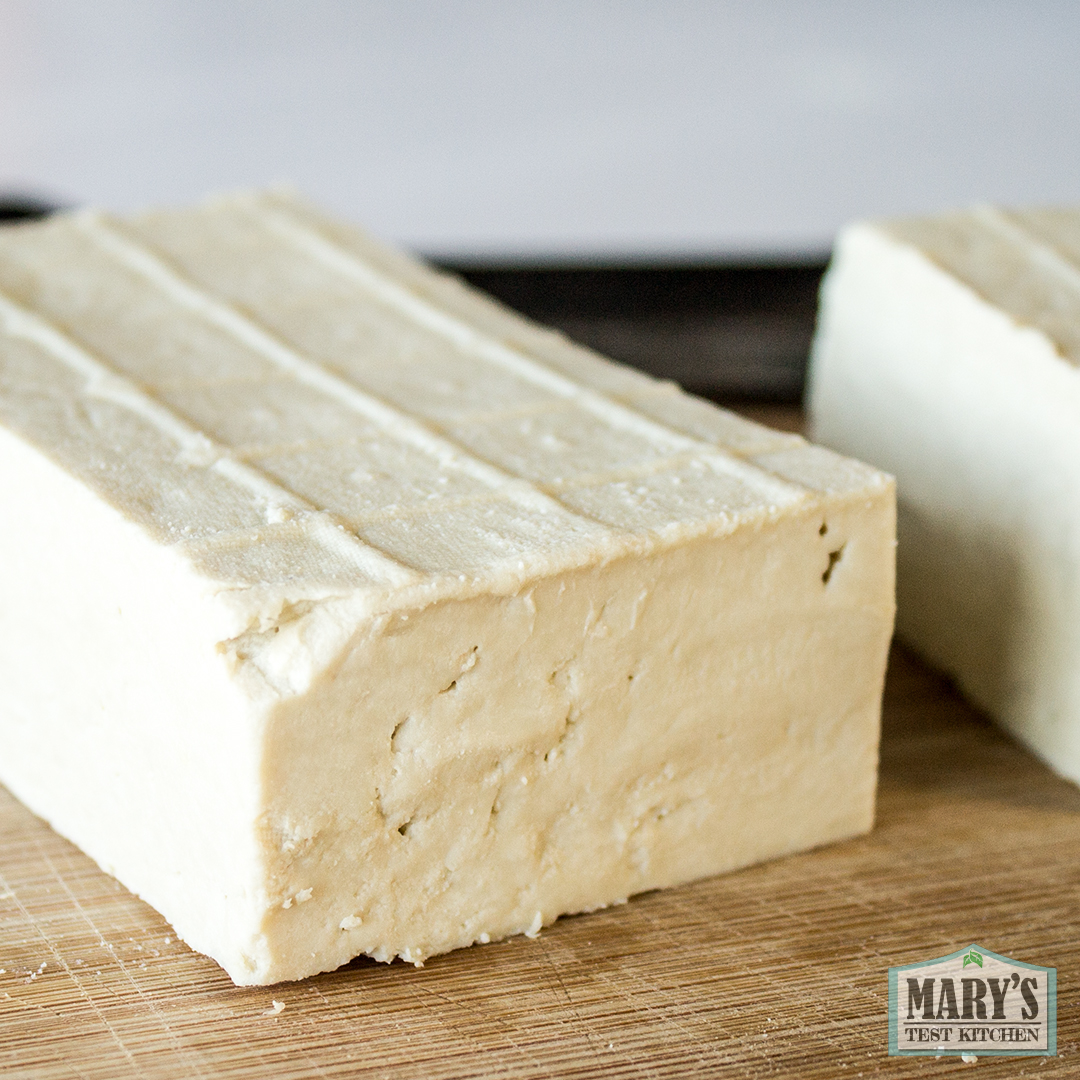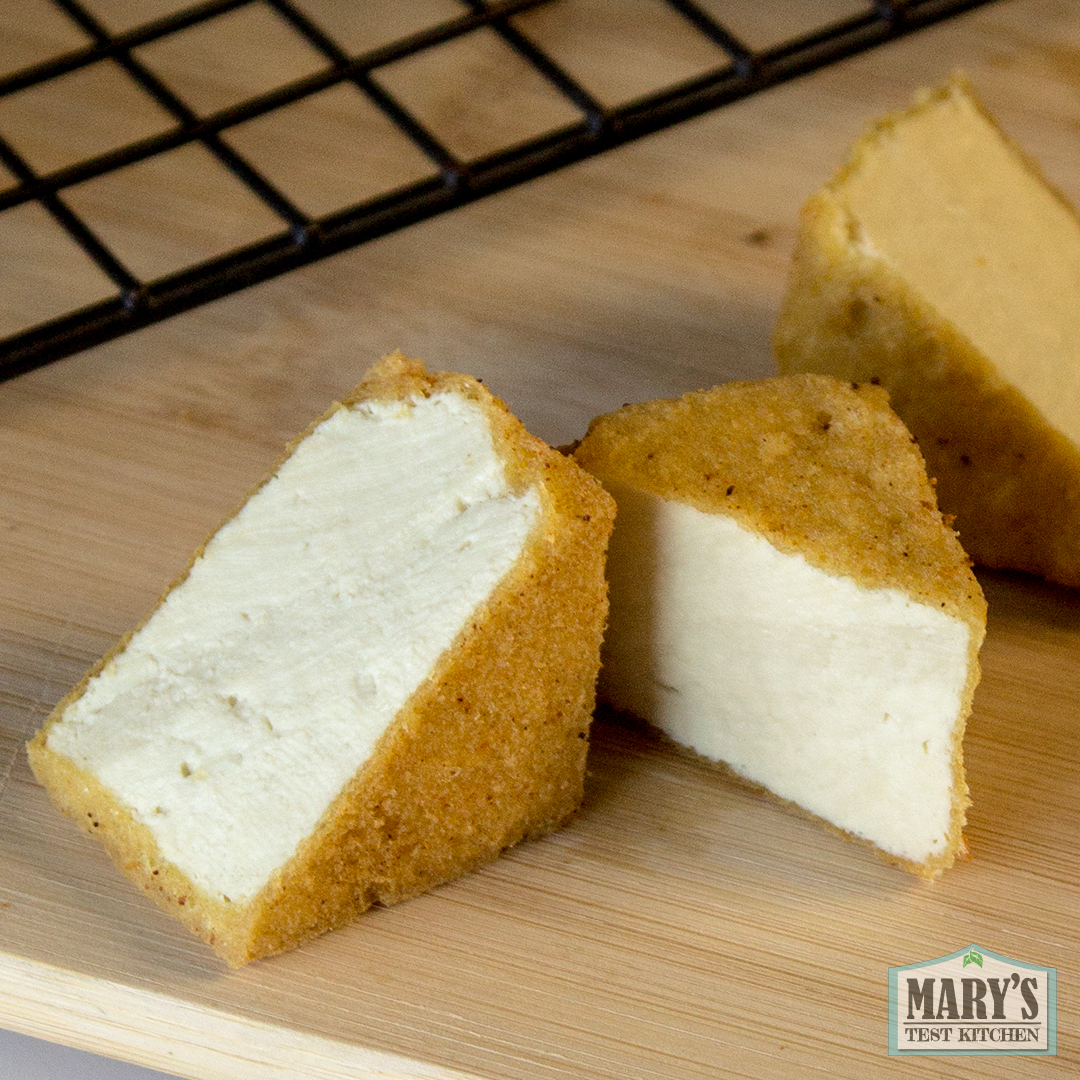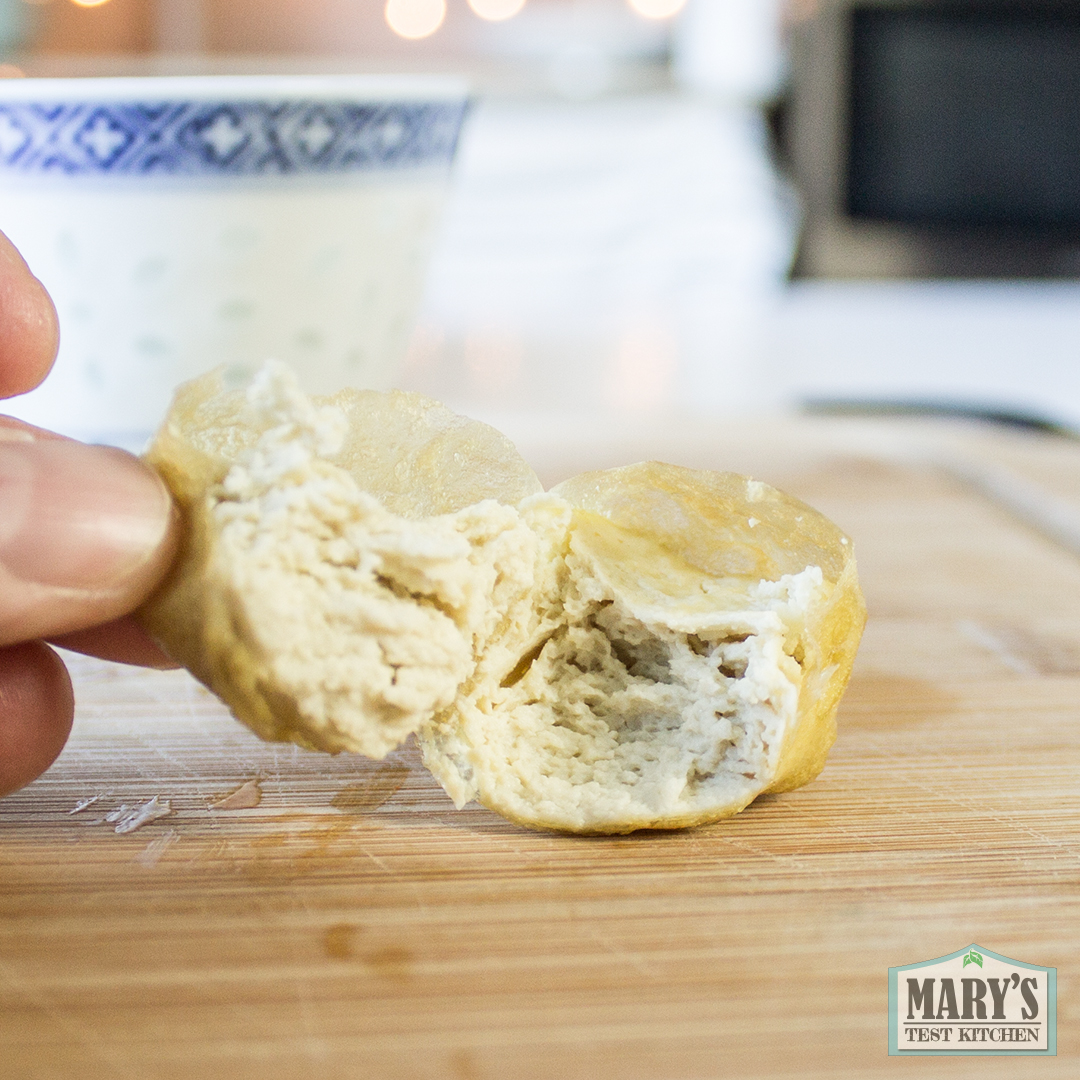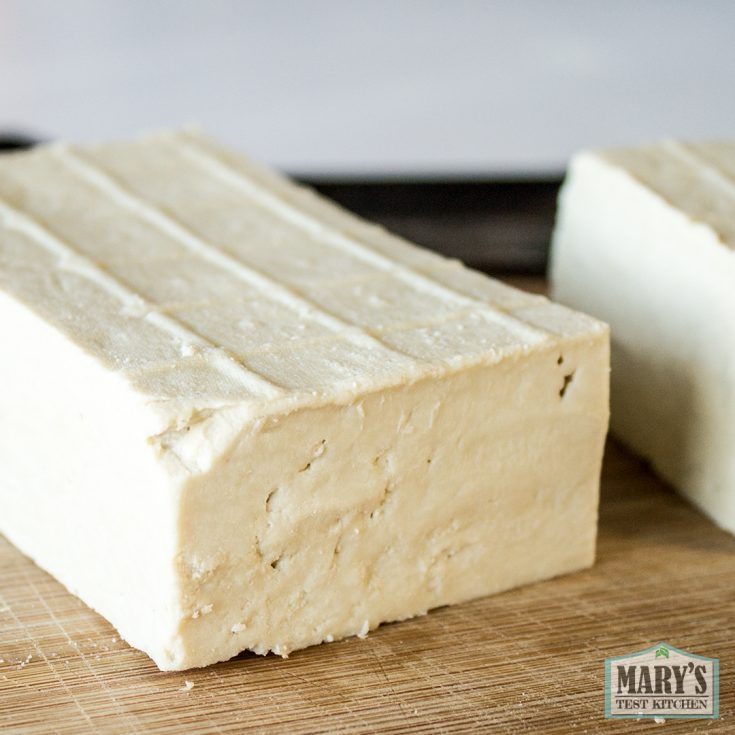Finally, there IS tofu without soy! This is soy-free tofu that’s high in protein and low carb making this tofu alternative particularly great for vegan keto diets or plant-based low carb diets. It’s also gluten-free and nut free. So what is this soy-free tofu made of? This one’s made of fava beans! The process for making fava beans tofu is very similar to the traditional method of making tofu with an extra step to remove the starch.
Try DIFFERENT Soy-Free Tofu’s too! Here are 9 soy-free tofu recipes and what to use them for.
Video Tutorial for How to Make High Protein Soy-Free Tofu (fava bean tofu)
Why Soy Free Tofu?
If you are allergic to soy or the people you are cooking for are, this is a great alternative so that you can still make tofu recipes without any soy! Personally, I eat a lot of soy but I believe it’s good to have variety when it comes to plant-based protein sources.

Beans and grains are great sources of vegan protein BUT if you are like me and cannot have too many carbohydrates, having protein sources that are not attached to a lot of sugars or starches is really important for health.
Why use Fava Beans for Soy Free Tofu
Fava Beans, like many beans, are great sources of vegan protein. They also don’t contain as much starch as some others which is why I had it on my list for testing. However, it was really seeing Big Mountain Food’s new soy-free tofu that really lit a fire under me to refine my process. I saw from their nutrition label that they were able to completely eliminate the carbohydrates while using fava beans as their base. So, I used a process similar to making wheat starch noodles. But instead of focusing on isolating and using the starch, I isolated and removed the starch.

What about Chickpea Soy-Free Tofu?
You may have seen my post on Burmese Tofu (chickpea tofu) and it’s really delicious BUT it’s not the same. I wanted to make a soy-free tofu alternative that still had the nutritional content similar to the original. That is, high in protein and low in carbohydrates. Chickpea tofu is very high in carbohydrates and doesn’t taste, feel or cook like regular soy-based tofu.
More recently, I made High Protein Chickpea Tofu. Check it out here.
On the other hand, my version of High Protein Soy-Free Tofu is very low in carbs and is mainly protein. In fact, it’s made almost exactly like regular tofu except for one extra step.

Fava Bean Tofu Tutorial
FYI, this post is still under construction! There are many notes I’d like to add but for now, I want to get the basic recipe and process out so you can have it. Please let me know if you have any questions.
More Tofu From Scratch
If you’re looking for more Soy-Free Tofu, check out
- Pink Tofu (high protein, lower carb with red lentils)
- Pumpkin Seed Tofu (high protein, high fat, low carb)
- Burmese Tofu (Chickpea Tofu)
- The Ultimate High Protein Soy-Free Tofu Roundup!
If you’re looking for how to make Soy Tofu, check out
Printable Recipe for High Protein Soy-Free Tofu (fava bean tofu)
High Protein Soy-Free Tofu (with Fava Beans)

This is soy-free tofu that's high in protein and low carb making this tofu alternative particularly great for vegan keto diets or plant-based low carb diets. It's also gluten-free and nut free.
Equipment required: blender, soy milk/ nut milk bag, tofu mold/press with cloth liner, large pot, spatula, and thermometer. with cloth liner
Ingredients
- 1 lb dried split fava beans (450g)
- 1 tbsp calcium sulfate (food grade gypsum)
- 1 cup room temperature water
Instructions
- Soak fava beans in plenty of water overnight. Rinse and drain fava beans. Then, transfer HALF to your blender along with 3 to 4 cups of fresh water. Blend on high for 15 seconds. Over a large bowl or pot (prefer glass bowl to see through), strain through soy/nut milk bag until pulp is very dry. Repeat with other half of beans.
- Let the milk rest for 10 minutes or longer to allow the starch to settle to the bottom of the bowl or pot. Then, use a cup to gently scoop only the milk while avoiding disturbing the starchy layer below. You will have to leave some of the milk behind as it won't be possible to get it all without starch contamination.
- If necessary, transfer milk to large cooking pot. Let it warm up over medium low heat while you prepare your coagulant. Mix room temperature water with 1 tbsp calcium sulfate and keep it nearby with a spoon ready.
- Turn heat up to medium high or high but stir constantly so that the milk does not burn to the bottom. When in doubt, lower the heat. Keep cooking until the milk reaches 180°F then turn off the heat. Immediately, stir up your coagulant again. Pick it up in one hand, keep stirring the milk and pour in HALF the coagulant slowly. Stand the spatula straight down to stop the spinning action. Cover and rest for 15 minutes.
- Afterwards, check on how it coagulated. If it is completely curdled, save the rest of your coagulant for another day. If not, spoon the remaining coagulant over the top surface and around the sides. Tap the top gently to move the curds softly. Then cover again and turn the heat to the lowest setting. Wait 10 minutes and re-check. All the milk should be coagulated.
- Moisten the cloth and line your tofu mold. With a slotted spoon, scoop the curds into the mold while holding the edges of the cloth so it doesn't fall in. Try to spread the curds in evenly. Then add the top and secure. If using my preferred tofu mold, just twist the knob until it stops; do not force it. Pour off excess water using the vents. Please in fridge to cool overnight. If using weights, use about 5 lbs of weight, pour off excess water and place in fridge. The next day, gently unmold and your high protein, soy-free tofu is ready to use!



Very cool — thank you for the super detailed recipe and video! I’ve never been brave enough to attempt tofu from scratch, but this may give me the extra motivation I need to try it.
Thank you also for mentioning that there’s absolutely nothing wrong with soya tofu unless you’re allergic to it. There’s so much misinformation about soya floating around that I appreciate when people take the time to correct the record.
BTW, I’ve also seen high protein, low carb tofu made from lupini beans, but I have no idea if the process is the same or if it requires a unique process.
Me gustaría hicieras tofú de lupini beans, es muy alto en proteína también y librede soja para alérgicos
Muchas gracias por tus recetas Mary!!!
Lupini tofu is coming 🙂 Thanks, Russa!
cheers,
Mary
Hi! Would this recipe still work of my dried fava beans are not split?
I think it should still work the same
Cheers,
Mary
thanks for the recipe !!
is there other ways to coagulate the bean milk other than gypsum or nigari ?
cant find either of them in my country.
You’re welcome! I used to use sour lemon juice when making soy tofu so that will probably work here too. That said, I haven’t tested it. If I was to try, I’d use 1 tablespoon of sour lemon juice in place of the gypsum.
I hope that helps!
-Mary
thanks for the replay! I will try making it with lemon juice .
after some search i did find gypsum but its sold as 98% calcium sulfate agricultural soil amendment, so i doubt that its the same as the one in the recipe.
Please let me know how it goes 🙂
And yes don’t use “soil amendment”! haha Gypsum comes in a food grade version which can be found at a wine/beer making supply store. Or ones labelled specifically for making tofu.
Cheers,
Mary
I just tried using lemon juice instead of gypsum but unfortunately it didn’t coagulate (I tried letting it sit for longer as well on low heat but it just stayed milky). Maybe I did something wrong but yeah I do not recommend lemon juice unless someone can figure out proper amounts. Oh well!
Update: I kept trying because I couldn’t accept it failing haha. I ended up adding about 2.5 tbsp lemon juice total, brought it back up to 180 degrees, then cut the heat and let it sit for 15 mins and SUCCESS. I put it in the tofu press and left it in the fridge for a few days then air fried and added it to my vegan Korean soldier stew and… it was super good. I’d say it’s an extreme extra firm with a chewier texture than soy tofu.
I tried making this recipe with “urid beans” (Vigna mungo), I thought due to their high protein content this would go great for sure! 😅 however, after two rounds of mixing and nutmilk bag, I let the liquid stand for ~ 1 hour and zero starch had settled at the bottom!
I tried to continue with the recipe anyway, but it did not curdle at all 😔 I feel that I failed on multiple levels 😅
Hi Mary,
Do you think this method would work with green split peas?
Sorry I haven’t tried so I can’t tell you. What I can say is I’ve tried with a few different types of beans and it’s only worked so far with fava beans and red lentils. Stay tuned for more experiments 🙂
I tried today with split green peas but it came.out a bit too soft, more than silken tofu. Maybe it’s because I used lemon juice instead of gypsum?
Thanks much, Mary, for the recipe and excellent step-by-step video. I’m looking forward to trying it. However, as you mentioned, dry fava / faba / broad beans are a little difficult to find.
Do you suppose it would work with canned faba beans? They’re a little easier to find, and already softened (although I suspect they may have been slightly blanched in the canning process).
I don’t really know. However I have not had luck making regular tofu with cooked soybeans so think you’d have difficultly using canned beans which are cooked to death.
Thank you for letting me know, Mary. I’ll trust your judgement on this. The Italian Market in Fairmount (for your Calgary fans) carries the beans.
Thank you for this! I have a soy allergy and it is so difficult to find high-protein, low-carb, easy-to-digest protein sources. I tried the big mountain soy-free tofu while I was in Canada and loved it, but its very difficult to find in the US.
Hi there! I can’t wait to try this out, is it possible to have the nutrient breakdown for this?
I’m curious what the macros are for this, thank you!
Hi There,
Do I need to dehull my Dried Fava beans for this recipe?
Thanks.
Jenn
I don’t think so
Hi,
Ok so you use dried fava beans and they havent been gulled is that correct? Ill give it ago and ill try the lemon thanks
Hello. I have tried making this twice and have failed both times. First time with lemon juice (the result ended up tasting sour and the tofu was grainy). The second time I used nigari and it taste nasty and won’t firm. Should I let it boil for a long time before adding nigari? It started to boil over so I turned it off and added the nigari water mixture and got nothing after waiting. I keep adding it in but still nothing. I’m at a loss. How much nigari do I add for about 9 cups of fava bean milk or about 1lb of dried fava beans?
Hi Mariah,
In this recipe, I use calcium sulphate (aka food grade gypsum). I like it because it’s reliable and doesn’t add a flavor (like the bitterness from nigari).
I have not tried making fava bean tofu with lemon juice or nigari. Theoretically, it should still work though.
If you haven’t, please take a look at the troubleshooting section at the end of this blog post: https://www.marystestkitchen.com/diy-tofu-just-soymilk-lemon-water/
The same issues that affect soy tofu may also apply to fava bean tofu.
Good luck!
-Mary
Do you know how much protein is in this tofu per 100g? Im going to make it this weekend but would like to now for my diet traking
I also track nutrition, and have the same question. I thought I could look at the nutrition info from Big Mountain brand, but not sure if this method removes 100% of the starch.
Let me know if you get an answer!
Same question for the other types of tofu – specifically chick pea and green and yellow split peas – all the firm ones.
I don’t eat soy based tofu or soy milk due to allergy, and I’m very new at tofu making.i first tried split dried fava beans, then I bought 10# dried whole fava beans for continued trial, and have gone through trying to soak unpeeled (purple like discoloration of resulting tofu went into compost bin) and soaked and peeled 1# with very tiny curds with magnesium sulfate (epsom salts), pretty small curds with magnesium chloride, and best but still quite small with calcium sulfate (gympsum)
So far I like soaked overnight then peeled whole dried fava beans with calcium sulfate coagulant best. I will keep making. 4 out of five batches have been edible.
That’s so interesting. Thanks so much for sharing your experience.
Hi there!
Could this work with fresh fava beans? I grow them every year and without fail end up with a glut! Would love to give this a go!
Many thanks
Hi Caitlin,
I would expect fresh fava beans could work based on the fact that fresh harvested mature soybeans have been traditionally used to make tofu. I don’t have access to fresh fava beans myself to try so I can’t say for sure, of course. I hope you give it a try and let me know how it goes 🙂
Cheers,
Mary
Can you make tofu with split mung beans?
Just a tip for those having trouble finding fava beans. I found split fava beans in an indian grocery store labeled “val dal.” It was less than $6 for 2 lbs.
Thanks for sharing, Amanda!
This is all so interesting. Mary thanks for sharing. I have really no desire to make tofu. I just saw the big mountain fava bean tofu on Instacart at sprouts farmers market in Raleigh North Carolina. I had never heard of it before so I searched for it and found your site. How does this stuff taste compared to sweeter food? I have never heard of Gypsum. I heard of nigiri because I’ve seen it on the packages of tofu but I didn’t know what it meant. I have had tofu that I found bitter, so maybe that was nigiri tofu. I love the sprouts organic marinated soy tofu. My son, 12 years old, will eat it right out of the package. ❤️
I’ve tried this recipe twice, once with nigari and once with gypsum, and it’s failed both times.
Barely curded, and it all slipped through the cheesecloth.
Any ideas?
I also track nutrition and would love to know the nutritional information. Is there a way to calculate from he measurements weighed during the tofu making process? This is a similar question as one higher up in this thread. I thought I could look at the nutrition info from Big Mountain brand, but not sure if this method removes 100% of the starch.
Same question for the other types of tofu – specifically chickpea and green and yellow split peas – all the firm ones.
Love these videos and I have tried this recipe twice now, and will continue to try.
:-DK
Hello, your YouTube channel and all your recipes are a treasure to me! Thank you very much.
But I’ve been struggling because I don’t know how much protein, carbs, and calories are in the quantities.
I would be grateful if you added nutritional information below each recipe, especially for protein-focused recipes such as tofu.
Hi eem,
I cannot give that information for these recipes since there is no way for me to measure them exactly. You can estimate the content based on the whole ingredient (in this case, fava beans), subtract most of the starch and fiber. What percent? How much? I would not feel comfortable estimating for you. Perhaps one day one of us will have the resources to have the results lab tested.
Good luck,
Mary
Have you found that this starch reduction process works with soy milk as well? Any idea on the impact to protein from this separation?
Hi Tony,
Thanks for your questions. Soybeans don’t have excess starch like fava beans do so you don’t need to have a starch reduction step. There’s no impact to the amount of protein as I can tell.
Hope that helps 🙂
Cheers,
Mary
HI Mary : ) Loved your video and thinking of making my own. Would you know the approximate weight (in grams?) of the block of tofu you are able to make from the 454 g of split faba beans? Thank you! Really enjoy your videos 🙂
Off the top of my head, I think it was about 250g of extra firm fava bean tofu.
-Mary
I am wondering what happens if you don’t add a coagulant. I don’t use a coagulant for lentil tofu or pumpkin tofu and they always turn out great. Have you tried making this without the coagulant? What was the result. Just curious before I try making my own. THANKS! Julie
Fava bean milk doesn’t self-coagulate the way pumpkin seed milk can. Or are you talking about high-carb “tofu” in the style of Burmese Tofu (cooked much like polenta)?
Hi Mary, how did you use the fava fiber? I am thinking of using to make little breads as you did for the chickpea tofu but if you have other suggestions they are welcome. I’ve already soaked the favas, I am ready to start 😉 Dry favas are so popular where I am from in Apulia. And I’ve been making for years a Turkish dish where you get like a fava pâté, it has dill in it. Liking the idea of making a dill flavored fava tofu!
In relation to the nutritional information of this tofu (or bean curd), I guess one could start calculating the nutritional information of the used fava beans and subtract the nutritional info of the reduced starch.
Starches are a form of carbohydrates, referred to as complex carbohydrates, which are a string of many simple sugars and contain, like sugars, 0 protein, and about 4 calories per gram. So reduce your sugars/carbs and calories by the amount of removed starch at the rate of (sugars/carbs – removed starch weight), calories – (4 x grams of removed starch weight). So lightly speaking, for this recipe, the nutritional information would be something like:
(see https://tools.myfooddata.com/nutrition-facts/168574/100g/4.5 for calculating the nutritional information of 450 grams of fava beans)
450 grams fava bean = 396 calories – (55 grams x 4 of removed starch=165) = 231 calories,
protein = 35.6g
Total carbs = 79.3g – 55g = 24.3g.
I wonder how the company big mountain fava bean tofu is able to get 64 grams of protein from there 340 gram package,and the whole package only contains 280 calories! That calorie to protein ratio is unbelievable!